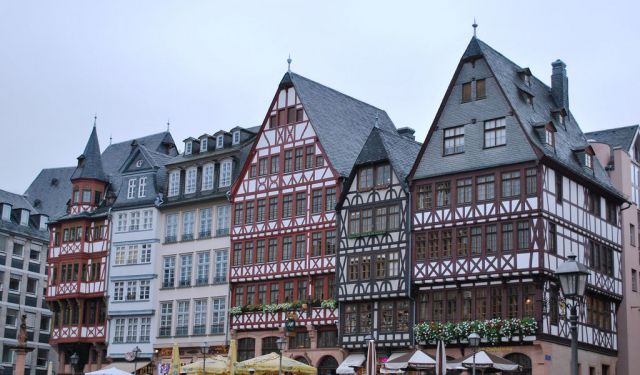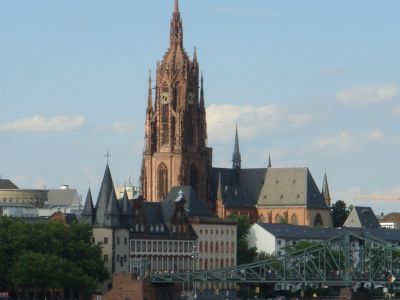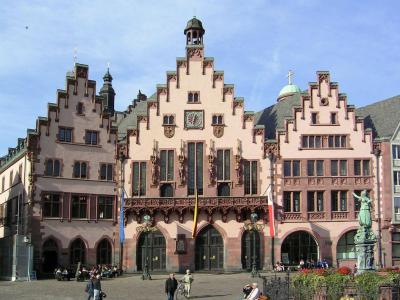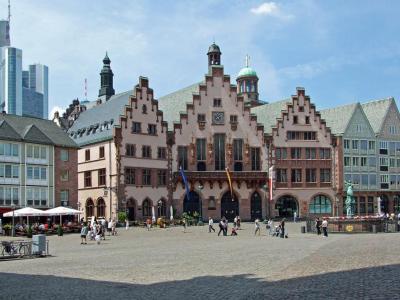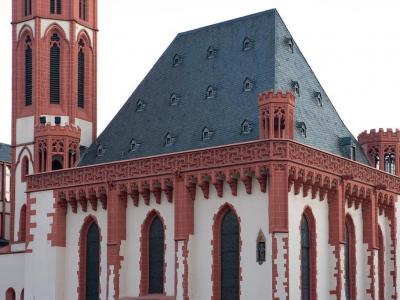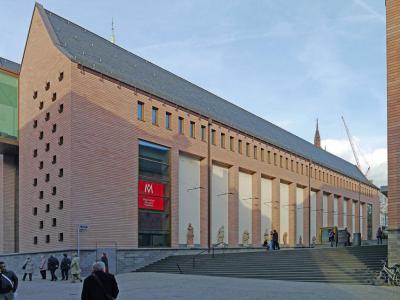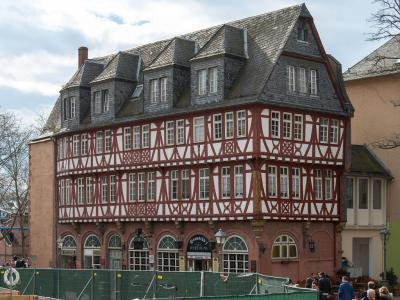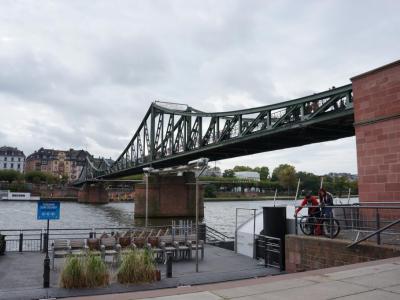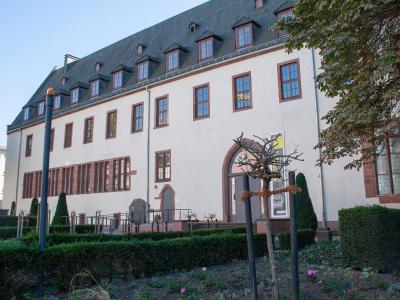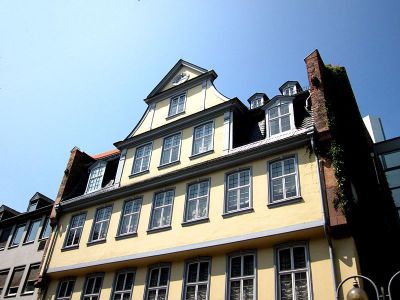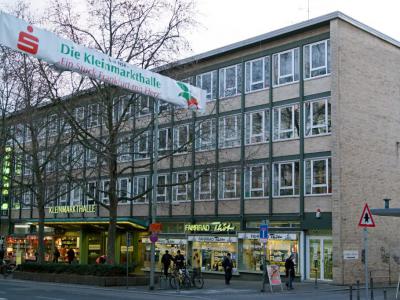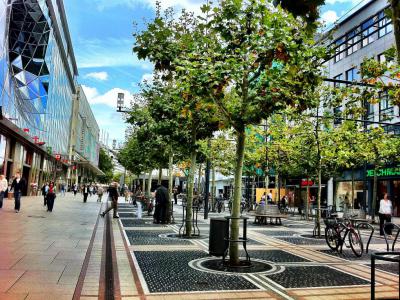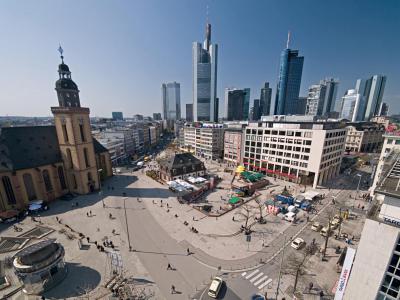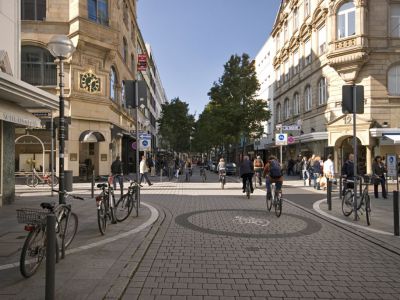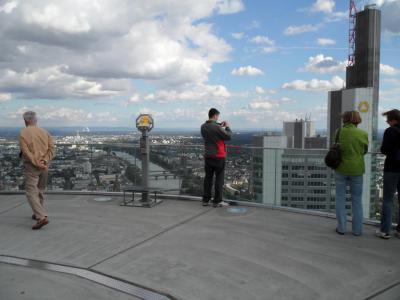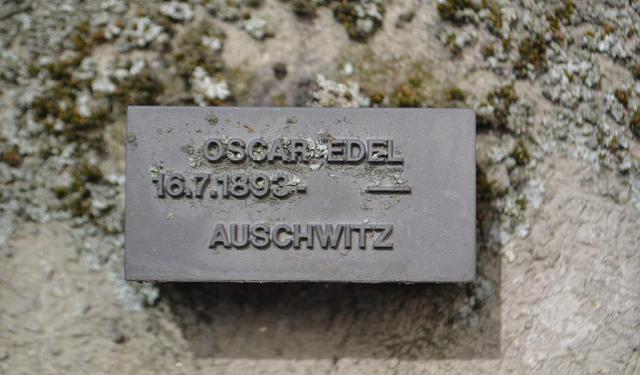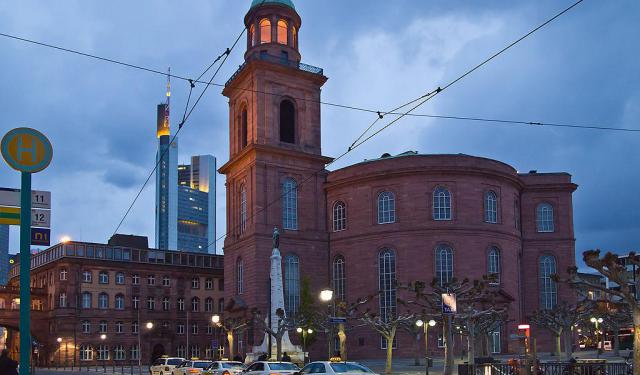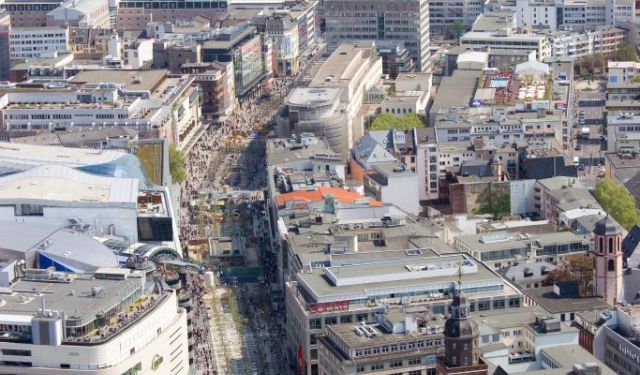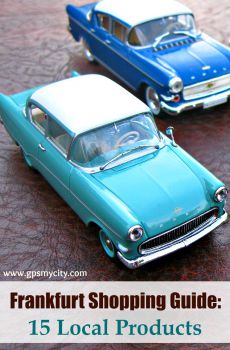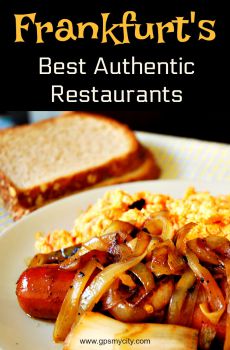Old Town Walking Tour (Self Guided), Frankfurt
The German city of Frankfurt, also known as Frankfurt am Main, has a long and complex history, spanning more than a thousand years. The Romans established a military camp called "Nida" in the area that is now Frankfurt, on the northern bank of the River Main, in the 1st century AD.
The town itself was founded by the Franks, a Germanic tribe, in the 9th century. Its name comes from the Old High German "Franconofurd," which means "ford of the Franks" and refers to the shallow place on the river that the Franks used for crossing on foot.
Frankfurt grew rapidly in the Middle Ages, becoming a free city-state and an important center for trade and commerce. It was granted a charter, in the 12th century, to hold its own markets and fairs. A remnant from the medieval period that is still in place is Römerberg, a public square and popular spot, home to the iconic Römer, Frankfurt's city hall.
In the 16th century, the city had the world's first stock exchange established and the Frankfurt Cathedral (aka Cathedral of St. Bartholomew) became a coronation site for all the kings and emperors of the Holy Roman Empire ever since.
A humorous proverb goes "All roads lead to Rome, but all alleys lead to Frankfurt." It probably harks back to the days of the Holy Roman Empire, reflecting the idea of Frankfurt being an important transportation hub, and its narrow, winding streets – an important part of the city's charm.
In the 16th and 17th centuries, Frankfurt was a center of the Reformation and the Enlightenment, and in the 18th century, enjoyed rich cultural and intellectual life. Johann Wolfgang von Goethe was born, lived, and worked here. His birthplace house is now a museum.
During World War II, Frankfurt was heavily bombed and suffered extensive damage, but was rebuilt after the war and has since become a thriving modern metropolis. The Main Tower, a 56-storey skyscraper, is a post-war addition to the landscape which offers a tremendous panorama of the city and the surrounding area from its observation deck.
“The real Frankfurt is hidden in the alleys of the Old Town,” they say, suggesting that the Old Town is the best place to experience the true spirit of Frankfurt and its history. You are welcome to put this proverb to a test and explore the many attractions of the Old Town of Frankfurt yourself on this self-guided walking tour.
The town itself was founded by the Franks, a Germanic tribe, in the 9th century. Its name comes from the Old High German "Franconofurd," which means "ford of the Franks" and refers to the shallow place on the river that the Franks used for crossing on foot.
Frankfurt grew rapidly in the Middle Ages, becoming a free city-state and an important center for trade and commerce. It was granted a charter, in the 12th century, to hold its own markets and fairs. A remnant from the medieval period that is still in place is Römerberg, a public square and popular spot, home to the iconic Römer, Frankfurt's city hall.
In the 16th century, the city had the world's first stock exchange established and the Frankfurt Cathedral (aka Cathedral of St. Bartholomew) became a coronation site for all the kings and emperors of the Holy Roman Empire ever since.
A humorous proverb goes "All roads lead to Rome, but all alleys lead to Frankfurt." It probably harks back to the days of the Holy Roman Empire, reflecting the idea of Frankfurt being an important transportation hub, and its narrow, winding streets – an important part of the city's charm.
In the 16th and 17th centuries, Frankfurt was a center of the Reformation and the Enlightenment, and in the 18th century, enjoyed rich cultural and intellectual life. Johann Wolfgang von Goethe was born, lived, and worked here. His birthplace house is now a museum.
During World War II, Frankfurt was heavily bombed and suffered extensive damage, but was rebuilt after the war and has since become a thriving modern metropolis. The Main Tower, a 56-storey skyscraper, is a post-war addition to the landscape which offers a tremendous panorama of the city and the surrounding area from its observation deck.
“The real Frankfurt is hidden in the alleys of the Old Town,” they say, suggesting that the Old Town is the best place to experience the true spirit of Frankfurt and its history. You are welcome to put this proverb to a test and explore the many attractions of the Old Town of Frankfurt yourself on this self-guided walking tour.
How it works: Download the app "GPSmyCity: Walks in 1K+ Cities" from Apple App Store or Google Play Store to your mobile phone or tablet. The app turns your mobile device into a personal tour guide and its built-in GPS navigation functions guide you from one tour stop to next. The app works offline, so no data plan is needed when traveling abroad.
Old Town Walking Tour Map
Guide Name: Old Town Walking Tour
Guide Location: Germany » Frankfurt (See other walking tours in Frankfurt)
Guide Type: Self-guided Walking Tour (Sightseeing)
# of Attractions: 14
Tour Duration: 2 Hour(s)
Travel Distance: 3.2 Km or 2 Miles
Author: helenp
Sight(s) Featured in This Guide:
Guide Location: Germany » Frankfurt (See other walking tours in Frankfurt)
Guide Type: Self-guided Walking Tour (Sightseeing)
# of Attractions: 14
Tour Duration: 2 Hour(s)
Travel Distance: 3.2 Km or 2 Miles
Author: helenp
Sight(s) Featured in This Guide:
- Frankfurt Cathedral (Cathedral of St. Bartholomew)
- Römer (City Hall)
- Römerberg (Square)
- Old Nicholas Church (Alte Nikolaikirche)
- Historisches Museum (History Museum)
- Haus Wertheim
- Eiserner Steg (Iron footbridge)
- Carmelite Monastery (Karmeliterkloster)
- Goethe-Haus
- Kleinmarkthalle (Small Market Hall)
- Zeil (Shopping Lane)
- Hauptwache (Main Guardroom Square)
- Goethestrasse (Goethe Street)
- Main Tower
1) Frankfurt Cathedral (Cathedral of St. Bartholomew) (must see)
Frankfurt Cathedral is a Gothic-style Roman Catholic temple dedicated to Saint Bartholomew. This is the main and by far the largest religious site in Frankfurt – the height of its spire reaches 95 meters. Despite the name – Kaiserdom (Imperial Cathedral), or simply the Dom, – it has never been a cathedral in the true sense of the word but is only called so for its importance as a former coronation church of the Holy Roman Empire.
The present building on the site is the third one. The very first church (Merovingian chapel) was built here in the 7th century, which was then replaced, by a grander temple, in 1250. In 1356, Charles IV, Holy Roman Emperor issued the Golden Bull whereby all emperors of the Holy Roman Empire were to be elected in this collegiate church as kings of Germany; from 1562 to 1792, all emperors-elect were crowned here.
In 1867, Saint Bartholomew's was destroyed by fire and rebuilt in its present style. During WWII, between October 1943 and March 1944, the Old Town of Frankfurt was devastated by the Allied Forces' air bombardments. The cathedral also suffered severe damage; its interior burned out completely and was reconstructed only in the 1950s.
Saint Bartholomew's houses many splendid works of art, including a unique high altar and the Maria Schlaf altar found in Saint Mary’s chapel. Also, there is an Anthony Van Dyke painting, ‘The Lamentation’, and a museum with many historic pieces including objects discovered in a grave of a Merovingian girl.
Why You Should Visit:
Admission is free and, if lucky, you may enjoy some impressive organ music, too, or take in panoramic views of Frankfurt from atop the cathedral's tower (for a small fee).
Tip:
Try and go on a weekday to avoid the weekend crowd; make sure to bring a bottle of water if you decide to climb the tower.
The present building on the site is the third one. The very first church (Merovingian chapel) was built here in the 7th century, which was then replaced, by a grander temple, in 1250. In 1356, Charles IV, Holy Roman Emperor issued the Golden Bull whereby all emperors of the Holy Roman Empire were to be elected in this collegiate church as kings of Germany; from 1562 to 1792, all emperors-elect were crowned here.
In 1867, Saint Bartholomew's was destroyed by fire and rebuilt in its present style. During WWII, between October 1943 and March 1944, the Old Town of Frankfurt was devastated by the Allied Forces' air bombardments. The cathedral also suffered severe damage; its interior burned out completely and was reconstructed only in the 1950s.
Saint Bartholomew's houses many splendid works of art, including a unique high altar and the Maria Schlaf altar found in Saint Mary’s chapel. Also, there is an Anthony Van Dyke painting, ‘The Lamentation’, and a museum with many historic pieces including objects discovered in a grave of a Merovingian girl.
Why You Should Visit:
Admission is free and, if lucky, you may enjoy some impressive organ music, too, or take in panoramic views of Frankfurt from atop the cathedral's tower (for a small fee).
Tip:
Try and go on a weekday to avoid the weekend crowd; make sure to bring a bottle of water if you decide to climb the tower.
2) Römer (City Hall) (must see)
The Römer ("Roman") is the Rathaus (City Hall) of Frankfurt and one of the main local historic landmarks. This medieval building has been in service for over 600 years and still houses offices of the local government.
In 1405, the Römer family of the wealthy Frankfurt merchants sold their house, along with the adjacent Goldener Schwan (Golden Swan) building, to the city council. Since then the property has continuously accommodated different civic offices until the present. Over the years, the complex has been expanded by the addition and purchase of nearby buildings, so today it represents a labyrinth of several structures connected by streets. A bridge, jokingly referred to as the “Bridge of Sighs” (after its famous counterpart in Venice), connects the Römer to the offices across the street. Two towers were added to the complex in the early 20th century. One of them is dubbed Langer Franz (Tall Franz) in homage to the city's tall mayor, and the other, smaller one, Kleiner Cohen (Small Cohen), after a popular song of the time.
Römerhalle and Schwanenhalle are the oldest rooms within the complex and are virtually unchanged after 600 years. They are found on the ground floor of the Römer and Goldener Schwan houses and can be entered directly from the main entrance in Römerberg.
Still, the main attraction of the Römer, perhaps, is the Kaisersaal (Emperor Hall) where coronation banquets of German Kings and Emperors of the Holy Roman Empire took place. The hall contains 52 portraits by famous artists of all the German Kings and Emperors, starting from Freidrich Barbarossa in 1152 to Franz II who was forced to abdicate by Napoleon in 1806. There is also an ornate balcony from where the rulers used to greet the crowds down below. The annual Christmas fair held in the square outside the City Hall is a regular attraction in its own right, drawing thousands of visitors from all over the world.
Why You Should Visit:
Truly an eye-catcher, even more interesting in the run-up to Christmas than during the rest of the year.
German history and culture are perfectly preserved in this Gingerbread part of town.
Tip:
Make sure you walk to the river to catch the Frankfurt cityscape which is only a few hundred meters away!
In 1405, the Römer family of the wealthy Frankfurt merchants sold their house, along with the adjacent Goldener Schwan (Golden Swan) building, to the city council. Since then the property has continuously accommodated different civic offices until the present. Over the years, the complex has been expanded by the addition and purchase of nearby buildings, so today it represents a labyrinth of several structures connected by streets. A bridge, jokingly referred to as the “Bridge of Sighs” (after its famous counterpart in Venice), connects the Römer to the offices across the street. Two towers were added to the complex in the early 20th century. One of them is dubbed Langer Franz (Tall Franz) in homage to the city's tall mayor, and the other, smaller one, Kleiner Cohen (Small Cohen), after a popular song of the time.
Römerhalle and Schwanenhalle are the oldest rooms within the complex and are virtually unchanged after 600 years. They are found on the ground floor of the Römer and Goldener Schwan houses and can be entered directly from the main entrance in Römerberg.
Still, the main attraction of the Römer, perhaps, is the Kaisersaal (Emperor Hall) where coronation banquets of German Kings and Emperors of the Holy Roman Empire took place. The hall contains 52 portraits by famous artists of all the German Kings and Emperors, starting from Freidrich Barbarossa in 1152 to Franz II who was forced to abdicate by Napoleon in 1806. There is also an ornate balcony from where the rulers used to greet the crowds down below. The annual Christmas fair held in the square outside the City Hall is a regular attraction in its own right, drawing thousands of visitors from all over the world.
Why You Should Visit:
Truly an eye-catcher, even more interesting in the run-up to Christmas than during the rest of the year.
German history and culture are perfectly preserved in this Gingerbread part of town.
Tip:
Make sure you walk to the river to catch the Frankfurt cityscape which is only a few hundred meters away!
3) Römerberg (Square) (must see)
Römerberg ("Roman Mountain") is the town hall square lying in front of (and subsequently named after) the Römer complex, the seat of the Frankfurt city administration since the 15th century. As the site of numerous imperial coronations, trade fairs, and Christmas markets, this square marks the historic heart of the medieval Altstadt (Old Town) and is a popular tourist destination. In the 20th century, Römerberg was the scene of many major events, both joyful and not so. On May 10, 1933, the infamous book burning organized by the Nazi German Student Union took place here. Between 1932 and 1939, the internationally renowned Römerberg Festival had been held here every summer, with nearly 350 open-air theater shows performed during the period.
Much of Römerberg's historical heritage, consisting of partly Gothic and partly Baroque architecture, was destroyed by Allied air raids in 1944. Today's square is the result of externally true to the original reconstructions and new buildings raised in the 1950s-1980s. The eastern part of Römerberg, also known as Samstagsberg (Saturday Mountain), represents a row of historical half-timbered houses, namely: Großer and Kleiner Engel, Goldener Greif, Wilder Mann, Kleiner Dachsberg, Großer Laubenberg, Kleiner Laubenberg, and Schwarzer Stern, built between 1981 and 1984. The name “Saturday Mountain” possibly comes from an open-air court that was held here every Saturday during the Carolingian era, when the Königspfalz Frankfurt lay east of the square. The Frankfurt Jews were only allowed to enter Römerberg during the fair, otherwise, they had to go to the Saturday market.
To the north, there are four new buildings featuring Neo-Gothic, Neo-Renaissance, and Neo-Baroque styles, replacing the six old houses demolished in 1906. In the south, Römerberg is presided over by the early Gothic Alte Nikolaikirche (Old Saint Nicholas Church). The new building of the Historical Museum, also located on the south side of the square, at the entrance to Saalgasse, was opened in October 2017.
The Fountain of Justice has been in Römerberg since 1543.
Much of Römerberg's historical heritage, consisting of partly Gothic and partly Baroque architecture, was destroyed by Allied air raids in 1944. Today's square is the result of externally true to the original reconstructions and new buildings raised in the 1950s-1980s. The eastern part of Römerberg, also known as Samstagsberg (Saturday Mountain), represents a row of historical half-timbered houses, namely: Großer and Kleiner Engel, Goldener Greif, Wilder Mann, Kleiner Dachsberg, Großer Laubenberg, Kleiner Laubenberg, and Schwarzer Stern, built between 1981 and 1984. The name “Saturday Mountain” possibly comes from an open-air court that was held here every Saturday during the Carolingian era, when the Königspfalz Frankfurt lay east of the square. The Frankfurt Jews were only allowed to enter Römerberg during the fair, otherwise, they had to go to the Saturday market.
To the north, there are four new buildings featuring Neo-Gothic, Neo-Renaissance, and Neo-Baroque styles, replacing the six old houses demolished in 1906. In the south, Römerberg is presided over by the early Gothic Alte Nikolaikirche (Old Saint Nicholas Church). The new building of the Historical Museum, also located on the south side of the square, at the entrance to Saalgasse, was opened in October 2017.
The Fountain of Justice has been in Römerberg since 1543.
4) Old Nicholas Church (Alte Nikolaikirche)
The Old Nicholas Church (German: Alte Nikolaikirche), located near the Römer city hall in the Old Town (Altstadt) of Frankfurt, is a medieval Lutheran temple dedicated to Saint Nicholas, the patron saint of fishermen. The current building dates back to the mid-15th century, replacing the original chapel on this site that stood since the mid-12th century. The foundations of the previous Nikolaikirche found during excavations are now marked on the floor and give the impression of its dimensions.
The Reformation proved a turning point in the history of Nikolaikirche. In the 15th century, the existing structure had a tower with leveled roof and a balcony added. The latter served as a viewing gallery for aristocrats when passion plays and other events took place in the plaza below. In 1543, the church was closed and its altars were demolished.
Over the next 150 years, the building was leased and used as an archive for the municipal jury and, at times, as a warehouse during trade fairs. A trumpeter watchman, stationed in the steeple, announced the arrival of boats up and down the River Main by blowing a horn. The bugle also sounded, like the modern-day alarm, whenever fires were sighted.
In 1838, the church was completely renovated. The previously closed northern portal facing Saturday Mountain was opened, and the roof, gallery, and corner turret were renewed. In 1903, the damaged cast-iron spire was torn down and replaced a year later by the pointed copper roof that still exists.
During World War II, the Alte Nikolaikirche was one of the very few historical buildings in downtown Frankfurt to be spared from destruction by aerial warfare. Only the 19th-century organ, despite being walled in, had become unusable from the effects of the war for reasons not quite known. The reconstruction of the building, which started in the summer of 1947, was completed relatively quickly, by the end of December 1948.
The church has a double aisle hall with a high Gothic choir and 51 bells, four of which are used for peals and 47 for carillons. The church is also renowned for its acoustics. Organ concerts, hand bells, trumpets, choirs, and brass bands perform here regularly. Another attraction is the spiral stairway leading to the gallery which affords a spectacular view of Romerberg Plaza.
The Reformation proved a turning point in the history of Nikolaikirche. In the 15th century, the existing structure had a tower with leveled roof and a balcony added. The latter served as a viewing gallery for aristocrats when passion plays and other events took place in the plaza below. In 1543, the church was closed and its altars were demolished.
Over the next 150 years, the building was leased and used as an archive for the municipal jury and, at times, as a warehouse during trade fairs. A trumpeter watchman, stationed in the steeple, announced the arrival of boats up and down the River Main by blowing a horn. The bugle also sounded, like the modern-day alarm, whenever fires were sighted.
In 1838, the church was completely renovated. The previously closed northern portal facing Saturday Mountain was opened, and the roof, gallery, and corner turret were renewed. In 1903, the damaged cast-iron spire was torn down and replaced a year later by the pointed copper roof that still exists.
During World War II, the Alte Nikolaikirche was one of the very few historical buildings in downtown Frankfurt to be spared from destruction by aerial warfare. Only the 19th-century organ, despite being walled in, had become unusable from the effects of the war for reasons not quite known. The reconstruction of the building, which started in the summer of 1947, was completed relatively quickly, by the end of December 1948.
The church has a double aisle hall with a high Gothic choir and 51 bells, four of which are used for peals and 47 for carillons. The church is also renowned for its acoustics. Organ concerts, hand bells, trumpets, choirs, and brass bands perform here regularly. Another attraction is the spiral stairway leading to the gallery which affords a spectacular view of Romerberg Plaza.
5) Historisches Museum (History Museum) (must see)
The Historisches Museum Frankfurt (Frankfurt History Museum) was founded in 1878. Aimed at recounting momentous events that have shaped the city, the museum houses several permanent exhibitions, featuring cultural and other objects relating to the history of Frankfurt - from the early medieval period to the present, as well as provides space for temporary exhibits.
Permanent exhibits are arranged in chronological order, taking visitors through the early medieval times when Frankfurt was a city-state, the late Middle Ages, the 16th-18th centuries, the 19th century, and the city between 1866 and 2001. Special exhibitions are also held regularly.
The HMF moved to its current location – the 12th-century Romanesque Palace, called Salhoff – in 1955. Today, it represents a complex of five historical buildings, plus a new exhibition hall and a small administration building replacing the extension built in 1972.
At the entry, visitors are greeted with a portrait of Charlemagne. Further inside, the museum treasures include the Saint Anne altarpiece from a Carmelite church, the Heller altarpiece by Albrecht Durer from a Dominican cloister, and a sculpture depicting the reconciliation of Emperor Otto I with his brother Heinrich by Alfred Rathel. Major attractions within the museum are the three scale models of the city made by the Treuner brothers: one showing medieval Frankfurt, the other showing the city after the 1944 bombardment, and a third modern postwar model of Frankfurt.
The Historisches Museum also has an interactive space for children, a large collection of porcelain, and a unique collection of comic books.
Why You Should Visit:
The museum marries old and new in its building and proves Frankfurt's importance as an international cultural hub.
All exhibits provide descriptions in German & English; the interactive digital info is a state of the art.
Sharp new connected buildings are a joy to be in; also, there is an awesome cafe with both inside & outside seating.
Tip:
Allow plenty of time if you're a first-time visitor, as the layout of the place can sometimes get confusing.
Permanent exhibits are arranged in chronological order, taking visitors through the early medieval times when Frankfurt was a city-state, the late Middle Ages, the 16th-18th centuries, the 19th century, and the city between 1866 and 2001. Special exhibitions are also held regularly.
The HMF moved to its current location – the 12th-century Romanesque Palace, called Salhoff – in 1955. Today, it represents a complex of five historical buildings, plus a new exhibition hall and a small administration building replacing the extension built in 1972.
At the entry, visitors are greeted with a portrait of Charlemagne. Further inside, the museum treasures include the Saint Anne altarpiece from a Carmelite church, the Heller altarpiece by Albrecht Durer from a Dominican cloister, and a sculpture depicting the reconciliation of Emperor Otto I with his brother Heinrich by Alfred Rathel. Major attractions within the museum are the three scale models of the city made by the Treuner brothers: one showing medieval Frankfurt, the other showing the city after the 1944 bombardment, and a third modern postwar model of Frankfurt.
The Historisches Museum also has an interactive space for children, a large collection of porcelain, and a unique collection of comic books.
Why You Should Visit:
The museum marries old and new in its building and proves Frankfurt's importance as an international cultural hub.
All exhibits provide descriptions in German & English; the interactive digital info is a state of the art.
Sharp new connected buildings are a joy to be in; also, there is an awesome cafe with both inside & outside seating.
Tip:
Allow plenty of time if you're a first-time visitor, as the layout of the place can sometimes get confusing.
6) Haus Wertheim
The Wertheim, also known as Wertheym, is a half-timbered house built around 1600 at the Fahrtor, between Romerplatz and the Main River. This is a listed building and the only house of its kind in the Old Town that has survived almost intact World War II. In large part due to this fact, much as for its unique Renaissance appearance (typical of the Frankfurt architectural style) and favorable position, this building is now very popular among tourists.
The name Wertheim was first mentioned in 1383, referring to the then owner of the property on this site, who probably came from Wertheim. The current building dates back to around 1600 and, apparently, initially served as a warehouse with the goods stored and traded in the open basement between the arcades or in the cellar vaults, especially during fairs in spring and autumn.
From the 17th to the 19th century, the Wertheim served as a customs house and facility for the city guard. In 1926, after renovation, there was a café and a restaurant on the ground floor.
The Wertheim was the only one of nearly 1,250 half-timbered houses in the Old Town to have come out largely unscathed from the air raids in World War II. Some credit it to an exit made in 1940 onto Römerberg, next to the extinguishing water basin at the Justice Fountain.
Still, it wasn't until 1963 that the Haus Wertheim was placed under monument protection which led to its eventual restoration in the mid-1970s. Following that, between 1981 and 1983, the half-timbered houses on Saturday Mountain had been reconstructed, and from 2012 to 2017 several historic streets had been built as part of the Dom-Römer project.
The name Wertheim was first mentioned in 1383, referring to the then owner of the property on this site, who probably came from Wertheim. The current building dates back to around 1600 and, apparently, initially served as a warehouse with the goods stored and traded in the open basement between the arcades or in the cellar vaults, especially during fairs in spring and autumn.
From the 17th to the 19th century, the Wertheim served as a customs house and facility for the city guard. In 1926, after renovation, there was a café and a restaurant on the ground floor.
The Wertheim was the only one of nearly 1,250 half-timbered houses in the Old Town to have come out largely unscathed from the air raids in World War II. Some credit it to an exit made in 1940 onto Römerberg, next to the extinguishing water basin at the Justice Fountain.
Still, it wasn't until 1963 that the Haus Wertheim was placed under monument protection which led to its eventual restoration in the mid-1970s. Following that, between 1981 and 1983, the half-timbered houses on Saturday Mountain had been reconstructed, and from 2012 to 2017 several historic streets had been built as part of the Dom-Römer project.
7) Eiserner Steg (Iron footbridge) (must see)
Eiserner Steg (Iron Bridge) is a pedestrian bridge over the river Main connecting the Old Town of Frankfurt with the Sachsenhausen district. It is also known as the “Love Lock Bridge” for being hung with tons of locks interlinked with each other, forming an enormous chain, a symbol of "eternal love".
The bridge has been in place since 1868 and was built initially through public subscription. The original version was replaced in 1912 with a widened, reinforced, and elevated construction. By that time the Main had become navigable upstream, so the low headroom of the Iron Bridge presented a traffic obstacle for large barges. Although its external appearance was retained for historical reasons, structurally – in terms of the load-bearing principle – the bridge was made completely different, switching from a suspension to a cantilever model.
After World War II, the Eiserne Steg was one of the first bridges in Germany to be rebuilt – in 1946 – after it had been blown up by the Wehrmacht in the last days of the war. In 1993, it underwent a complete renovation, prompted by decades-long corrosion gnawing at the steel, following which two elevators and prams were also added to ease access for wheelchairs. The bridge now has a clearance height of 6.50 meters.
The Greek motto, a quote from Homer's Odyssey: ΠΛΕΩΝ ΕΠΙ ΟΙΝΟΠΑ ΠΟΝΤΟΝ ΕΠ ΑΛΛΟΘΡΟΟΥΣ ΑΝΘΡΩΠΟΥΣ (“Sailing on the dark sea to people of another tongue”), spanning the steel construction over the northern pillar, was created by artist Hagen Bonifer in 1999 to celebrate the year of Goethe.
Tip:
If you're into photography, come here at sunset and you'll be able to take some very nice shots of Frankfurt's skyline (but be ready for a crowd).
The bridge has been in place since 1868 and was built initially through public subscription. The original version was replaced in 1912 with a widened, reinforced, and elevated construction. By that time the Main had become navigable upstream, so the low headroom of the Iron Bridge presented a traffic obstacle for large barges. Although its external appearance was retained for historical reasons, structurally – in terms of the load-bearing principle – the bridge was made completely different, switching from a suspension to a cantilever model.
After World War II, the Eiserne Steg was one of the first bridges in Germany to be rebuilt – in 1946 – after it had been blown up by the Wehrmacht in the last days of the war. In 1993, it underwent a complete renovation, prompted by decades-long corrosion gnawing at the steel, following which two elevators and prams were also added to ease access for wheelchairs. The bridge now has a clearance height of 6.50 meters.
The Greek motto, a quote from Homer's Odyssey: ΠΛΕΩΝ ΕΠΙ ΟΙΝΟΠΑ ΠΟΝΤΟΝ ΕΠ ΑΛΛΟΘΡΟΟΥΣ ΑΝΘΡΩΠΟΥΣ (“Sailing on the dark sea to people of another tongue”), spanning the steel construction over the northern pillar, was created by artist Hagen Bonifer in 1999 to celebrate the year of Goethe.
Tip:
If you're into photography, come here at sunset and you'll be able to take some very nice shots of Frankfurt's skyline (but be ready for a crowd).
8) Carmelite Monastery (Karmeliterkloster)
Formerly the convent of the Carmelite order, from 1246 to 1803, the Karmeliterkloster today houses the Institute for the History of Frankfurt and the Archaeological Museum.
After the Carmelites established themselves in Frankfurt in the mid-13th century, the monastery quickly gained footing and soon proved to be one of the largest building complexes in the Old Town. In 1424, its original single-vessel church was remodeled to the late Gothic style, with a chapel and two-aisle refectory hall added. The latter was richly adorned with frescoes, the largest in Northern Europe, including the painted history of the Carmelite order and the depiction of Christ’s birth and death by Jorg Ratgeb (the 16th-century artist who was later cruelly executed for partaking in the German peasant revolution of 1525).
Following the secularization of Frankfurt in 1803, the city claimed all the monastery's possessions, including 25 hectares of vineyards in Hochheim am Main. Over the years, the convent's main building served as a warehouse, garrison, fire department, and theater. It was almost destroyed during World War II and its frescoes were severely damaged. The building was finally refurbished in 1987-1989.
Since 1959, the Carmelite Monastery has housed the Institute for the History of Frankfurt (formerly the municipal archives) and the Archaeological Museum (once known as the Museum of Prehistory and Early History). Also on the premises, in the basement, is a cabaret theater called Die Schmiere (The Grease), staging satirical plays and much loved by the local theater-goers.
After the Carmelites established themselves in Frankfurt in the mid-13th century, the monastery quickly gained footing and soon proved to be one of the largest building complexes in the Old Town. In 1424, its original single-vessel church was remodeled to the late Gothic style, with a chapel and two-aisle refectory hall added. The latter was richly adorned with frescoes, the largest in Northern Europe, including the painted history of the Carmelite order and the depiction of Christ’s birth and death by Jorg Ratgeb (the 16th-century artist who was later cruelly executed for partaking in the German peasant revolution of 1525).
Following the secularization of Frankfurt in 1803, the city claimed all the monastery's possessions, including 25 hectares of vineyards in Hochheim am Main. Over the years, the convent's main building served as a warehouse, garrison, fire department, and theater. It was almost destroyed during World War II and its frescoes were severely damaged. The building was finally refurbished in 1987-1989.
Since 1959, the Carmelite Monastery has housed the Institute for the History of Frankfurt (formerly the municipal archives) and the Archaeological Museum (once known as the Museum of Prehistory and Early History). Also on the premises, in the basement, is a cabaret theater called Die Schmiere (The Grease), staging satirical plays and much loved by the local theater-goers.
9) Goethe-Haus (must see)
Grosser Hirschgraben 23 in Frankfurt is the place where philosopher-writer Johann Wolfgang Von Goethe was born and raised, and where he wrote his famous works: Götz von Berlichingen, Faust, and The Sorrows of Young Werther. The house was destroyed during World War II but was reconstructed with loving care to its 17th-century splendor, in memory of Frankfurt’s best-known son, by the local citizens.
The museum opened to the public in 1863 and has since remained a shrine for Goethe enthusiasts from all over the world. Decorated with period furniture and paintings, it provides an authentic environment in which Goethe spent his youth, reflecting the lifestyle enjoyed by affluent 17th-century Germans, featuring various Baroque, Neoclassical, and Rococo elements. Among the rooms painstakingly restored after the war are the library where Wolfgang Goethe’s father worked and looked out for the return of his son, and the portrayal of an authentic 17th-century German Kitchen.
The puppet theater that Goethe treasured enough to make the focal point of his novel 'Wilhelm Meister's Apprenticeship' is also on view. One of the treasures within the house is a large classic clock on the 2nd floor that tells the time, date, the lunar and solar year. The building houses Goethe’s father’s vast collection of art, including paintings by well-known Frankfurt artists. The adjacent Frankfurter Goethe Museum contains books, works of art, and manuscripts all related, in some way or other, to Goethe.
Goethe House is open through the week and is free for children under 6. Visitors can request the help of volunteers to understand the significance of every Goethe-related object on display.
Why You Should Visit:
More than you'd normally expect; apart from the house itself (completely nice to see), you can visit a gallery (up the staircase) that is no smaller than some art museums you'd want to pay much to visit. Great value!
Tip:
Good to either take an audio guide or make sure to grab a pamphlet at the entrance in the relevant language.
The museum opened to the public in 1863 and has since remained a shrine for Goethe enthusiasts from all over the world. Decorated with period furniture and paintings, it provides an authentic environment in which Goethe spent his youth, reflecting the lifestyle enjoyed by affluent 17th-century Germans, featuring various Baroque, Neoclassical, and Rococo elements. Among the rooms painstakingly restored after the war are the library where Wolfgang Goethe’s father worked and looked out for the return of his son, and the portrayal of an authentic 17th-century German Kitchen.
The puppet theater that Goethe treasured enough to make the focal point of his novel 'Wilhelm Meister's Apprenticeship' is also on view. One of the treasures within the house is a large classic clock on the 2nd floor that tells the time, date, the lunar and solar year. The building houses Goethe’s father’s vast collection of art, including paintings by well-known Frankfurt artists. The adjacent Frankfurter Goethe Museum contains books, works of art, and manuscripts all related, in some way or other, to Goethe.
Goethe House is open through the week and is free for children under 6. Visitors can request the help of volunteers to understand the significance of every Goethe-related object on display.
Why You Should Visit:
More than you'd normally expect; apart from the house itself (completely nice to see), you can visit a gallery (up the staircase) that is no smaller than some art museums you'd want to pay much to visit. Great value!
Tip:
Good to either take an audio guide or make sure to grab a pamphlet at the entrance in the relevant language.
10) Kleinmarkthalle (Small Market Hall)
The Kleinmarkthalle is a market hall in the Old Town of Frankfurt. On working days, 63 retailers in 156 market stalls in an area of around 1,500 square meters offer fresh food, flowers, and seeds here. Nowadays, in addition to regional specialties, like green sauce, imported foods are also sold in this market. Some dealers operate snack stands inside the hall as well. This makes Kleinmarkthalle a retail center of importance for the entire Rhine-Main region.
What to buy here: Frankfurter in a can.
Frankfurt lends its name to the pork sausages known around the world as the “frankfurter”. Although it tastes best fresh, at least one butcher has come up with a canned product suitable as an edible city souvenir that can be transported long distances. The history of Gref-Völsings goes back to 1894 and the founding of a butchery by the same name. Gref-Völsings products are found all over town, in supermarkets, gas stations, restaurants, and butcher shops. For its canned products, the company uses a traditional design to pack its sausages. Frankfurters are long and slender, and a half-dozen will fit into a can that sells for about 6 euros. Suggestions for both fresh and canned Frankfurters are butchers’ Metzgerei Ullmann or Schoen in the city market at Kleinmarkthalle, Hasengasse 5-7, 60311 Frankfurt.
What to buy here: Frankfurter in a can.
Frankfurt lends its name to the pork sausages known around the world as the “frankfurter”. Although it tastes best fresh, at least one butcher has come up with a canned product suitable as an edible city souvenir that can be transported long distances. The history of Gref-Völsings goes back to 1894 and the founding of a butchery by the same name. Gref-Völsings products are found all over town, in supermarkets, gas stations, restaurants, and butcher shops. For its canned products, the company uses a traditional design to pack its sausages. Frankfurters are long and slender, and a half-dozen will fit into a can that sells for about 6 euros. Suggestions for both fresh and canned Frankfurters are butchers’ Metzgerei Ullmann or Schoen in the city market at Kleinmarkthalle, Hasengasse 5-7, 60311 Frankfurt.
11) Zeil (Shopping Lane)
Once the center of a large cattle trade in Frankfurt, this busy lane has been one of the most famous shopping venues in Germany since the end of the 19th century. The Zeil is a shoppers’ paradise where visitors with varied budgets can find a range of products suiting their pockets, from mid-priced supermarket fare to high-end merchandise. Luxury goods, designer brands, handicrafts, clothes by young Frankfurt designers, and more are found here in rich supply. There are outlets of all the major German retail chains, plus those offering products from the Frankfurt area.
The name Zeil dates back to the 14th century, and is derived from the German word Zeile, which means "row". Originally, it referred to a row of houses on the eastern end of the north side and was not extended to the entire street until later.
Prior to World War II, the Zeil hosted an array of grand buildings, most of which were destroyed and never rebuilt. Its western part, between two large plazas – Hauptwache in the west and Konstablerwache in the east, is now a pedestrian zone. These plazas serve as major intersections for underground trains, trams, and buses. Following a major renovation in 2008-2009, the Zeil pedestrian zone was extended to the west, as far as the Börsenstrasse.
The three edifices dominating the Zeil today include the Zeilgalerie, a 10-storey shopping center with a unique spiral design, home to many music- and electronic stores and restaurants. Another grand is a shopping center, called the Palais Quartier, a blend of Modern and Baroque architecture; it has a spectacular vortex-like glass façade, glass columns, and irregularly shaped ramps. And finally, the 12-storey Beehive House, a commercial and office building, which is also one of Frankfurt’s earliest skyscrapers.
Why You Should Visit:
A unique shopping experience in what could be referred to as an "outdoor shopping mall"; a perfect place to acclimate to Europe if you arrive in Frankfurt – fun to shop, eat and explore, while admiring the architecture. As a bonus, you don't need to worry about cars while crossing the street either.
The name Zeil dates back to the 14th century, and is derived from the German word Zeile, which means "row". Originally, it referred to a row of houses on the eastern end of the north side and was not extended to the entire street until later.
Prior to World War II, the Zeil hosted an array of grand buildings, most of which were destroyed and never rebuilt. Its western part, between two large plazas – Hauptwache in the west and Konstablerwache in the east, is now a pedestrian zone. These plazas serve as major intersections for underground trains, trams, and buses. Following a major renovation in 2008-2009, the Zeil pedestrian zone was extended to the west, as far as the Börsenstrasse.
The three edifices dominating the Zeil today include the Zeilgalerie, a 10-storey shopping center with a unique spiral design, home to many music- and electronic stores and restaurants. Another grand is a shopping center, called the Palais Quartier, a blend of Modern and Baroque architecture; it has a spectacular vortex-like glass façade, glass columns, and irregularly shaped ramps. And finally, the 12-storey Beehive House, a commercial and office building, which is also one of Frankfurt’s earliest skyscrapers.
Why You Should Visit:
A unique shopping experience in what could be referred to as an "outdoor shopping mall"; a perfect place to acclimate to Europe if you arrive in Frankfurt – fun to shop, eat and explore, while admiring the architecture. As a bonus, you don't need to worry about cars while crossing the street either.
12) Hauptwache (Main Guardroom Square) (must see)
Hauptwache is a central point of Frankfurt and one of the most famous plazas in the city. The original name Schillerplatz was superseded in the early 1900s. The Hauptwache ("Main Guardroom") building, which gave the square its current name, dates back to 1730 and was designed by German master builder Johann Samhammer. It features red sandstone Baroque-style exterior and a hipped Gothic-style triangular roof with three chimneys.
The original purpose of the place was to house the headquarters of the city's Stadtwehr militia and prison when Frankfurt was an independent city-state. The Hauptwache went down in history when it was stormed by student activists in a failed attempt at freeing political prisoners in 1833, called the Frankfurter Wachensturm. The building then served as a police station and, in 1904, became a cafe which it remains to this day. It marks one end of the Zeil and adds a great deal of old-world architectural charm to this busy part of Frankfurt.
On 7 April 1920, the square was the scene of yet another Hauptwache incident when French troops opened fire on students protesting against the French occupation of Frankfurt. Heavily burned in World War II bombing, the building was reopened in a provisional form with an altered roof in 1954. In 1967, amid the construction of the U-Bahn tunnel through the city, the Hauptwache edifice was dismantled, moved, and then rebuilt over the new underground U-Bahn station.
Today, Hauptwache station is one of the most important crosspoints of the Frankfurt public transport system, served by eight S-Bahn and six U-Bahn lines. A key element of the plaza is a sunken terrace leading down to the station and an underground pedestrian area with shops, dubbed by the locals as "das Loch" (the Hole).
Visitors, commuters, and shoppers can enjoy a light refreshing meal at the Hauptwache café with its quaint ambiance reminiscent of a momentous past. Apart from it, the surrounding buildings are mostly modern high risers, except for the imposing Saint Catherine's Church.
Tip:
If the weather permits, sit down and have a glass of beer, glühwein, or Frankfurter apple wine outside the Hauptwache.
If you're lucky, there will be an apple wine festival when you arrive; then you could mingle with the local professionals, wine-lovers, and travelers alike.
The original purpose of the place was to house the headquarters of the city's Stadtwehr militia and prison when Frankfurt was an independent city-state. The Hauptwache went down in history when it was stormed by student activists in a failed attempt at freeing political prisoners in 1833, called the Frankfurter Wachensturm. The building then served as a police station and, in 1904, became a cafe which it remains to this day. It marks one end of the Zeil and adds a great deal of old-world architectural charm to this busy part of Frankfurt.
On 7 April 1920, the square was the scene of yet another Hauptwache incident when French troops opened fire on students protesting against the French occupation of Frankfurt. Heavily burned in World War II bombing, the building was reopened in a provisional form with an altered roof in 1954. In 1967, amid the construction of the U-Bahn tunnel through the city, the Hauptwache edifice was dismantled, moved, and then rebuilt over the new underground U-Bahn station.
Today, Hauptwache station is one of the most important crosspoints of the Frankfurt public transport system, served by eight S-Bahn and six U-Bahn lines. A key element of the plaza is a sunken terrace leading down to the station and an underground pedestrian area with shops, dubbed by the locals as "das Loch" (the Hole).
Visitors, commuters, and shoppers can enjoy a light refreshing meal at the Hauptwache café with its quaint ambiance reminiscent of a momentous past. Apart from it, the surrounding buildings are mostly modern high risers, except for the imposing Saint Catherine's Church.
Tip:
If the weather permits, sit down and have a glass of beer, glühwein, or Frankfurter apple wine outside the Hauptwache.
If you're lucky, there will be an apple wine festival when you arrive; then you could mingle with the local professionals, wine-lovers, and travelers alike.
13) Goethestrasse (Goethe Street)
There aren't that many cities out there where most of the world’s finest luxury labels have taken up residence in a single street. Goethestrasse (Goethe Street) is one such avenue, where even the most discerning shoppers can find everything they want, all within a few steps, making it one of the most famous and the third busiest shopping lane in Germany.
Nicknamed Luxusgasse (‘luxury lane’) or Frankfurt's Fifth Avenue, this tree-lined street provides visitors with almost 300 meters of temptation and is named after Johann Wolfgang von Goethe, a German writer and statesman. Built between 1892 and 1894, it has since survived more than one chapter of Germany’s turbulent history and is now home to a mix of classical, modernist, and contemporary buildings that play host to some of the world’s biggest brands and most revered labels.
Goethestrasse features the latest collections of top international designers, such as Armani, Bally, Bulgari, Burberry, Chanel, Ermenegildo Zegna, Gucci, Hermès, Hugo Boss, Jil Sander, Louis Vuitton, Longchamp, Jimmy Choo, Montblanc, Patek Philippe, Prada, Salvatore Ferragamo, Tiffany & Co., Tumi, Versace, and Vertu. Apart from the designer clothing, there are also high-end boutiques offering selected jewelry from exclusive brands, like Cartier and Tiffany. In addition, this shopping street also caters to those seeking art, household items, and eyewear.
Nicknamed Luxusgasse (‘luxury lane’) or Frankfurt's Fifth Avenue, this tree-lined street provides visitors with almost 300 meters of temptation and is named after Johann Wolfgang von Goethe, a German writer and statesman. Built between 1892 and 1894, it has since survived more than one chapter of Germany’s turbulent history and is now home to a mix of classical, modernist, and contemporary buildings that play host to some of the world’s biggest brands and most revered labels.
Goethestrasse features the latest collections of top international designers, such as Armani, Bally, Bulgari, Burberry, Chanel, Ermenegildo Zegna, Gucci, Hermès, Hugo Boss, Jil Sander, Louis Vuitton, Longchamp, Jimmy Choo, Montblanc, Patek Philippe, Prada, Salvatore Ferragamo, Tiffany & Co., Tumi, Versace, and Vertu. Apart from the designer clothing, there are also high-end boutiques offering selected jewelry from exclusive brands, like Cartier and Tiffany. In addition, this shopping street also caters to those seeking art, household items, and eyewear.
14) Main Tower (must see)
Named after the nearby Main River, the Main Tower is a 56-storey, 200 meters (656 feet) skyscraper, the 4th tallest building in Frankfurt and all of Germany. Complete with its antenna spire, the building stands 240 meters (787 feet) high. The tower has five underground floors and two public viewing platforms and is the only skyscraper in Frankfurt with a public viewing observatory.
The building's design features what appears to be two connected towers: the smaller, cuboid one with a glass façade, common to the 1970s architecture; and the second, taller one, of a circular shape clad entirely in blue colored glass, featuring the transmission tower on top.
Construction of the Main Tower began in 1996 and was completed in 1999. The tower has 55 floors with functioning windows making it an eco-friendly modern high-rise structure. The building houses the offices of several German and international banks and is virtually the financial center of Frankfurt. There are also television and radio stations. During TV weather reports, the reporter stands on top of the building.
In the foyer, there are two art pieces accessible to the public: the video installation by Bill Viola "The World of Appearances" and the wall mosaic by Stephan Huber "Frankfurter Treppe / XX. Jahrhundert" ("Frankfurt's Steps/20th century").
Visitors to the observation deck at the top floor are encouraged to take a map to spot Frankfurt’s numerous landmarks from atop. One floor below is a restaurant and bar with large windows offering a panoramic 360-degree panorama of the city. On clear days you can see as far as the Mainz, Wiesbaden, Hanau, and Taunus Mountains.
Why You Should Visit:
There are a few elevated places in Frankfurt which provide amazing views of the city, but the Main Tower has to be the tallest and the best among them.
Unlike some other observation decks, the top of the Main Tower is completely open other than a low railing. There's no glass between you and the sky.
Tip:
Go before sunset to see Frankfurt in daylight and 20 minutes later in the light of a big city.
Also, make sure to wrap up if going during the colder months.
The building's design features what appears to be two connected towers: the smaller, cuboid one with a glass façade, common to the 1970s architecture; and the second, taller one, of a circular shape clad entirely in blue colored glass, featuring the transmission tower on top.
Construction of the Main Tower began in 1996 and was completed in 1999. The tower has 55 floors with functioning windows making it an eco-friendly modern high-rise structure. The building houses the offices of several German and international banks and is virtually the financial center of Frankfurt. There are also television and radio stations. During TV weather reports, the reporter stands on top of the building.
In the foyer, there are two art pieces accessible to the public: the video installation by Bill Viola "The World of Appearances" and the wall mosaic by Stephan Huber "Frankfurter Treppe / XX. Jahrhundert" ("Frankfurt's Steps/20th century").
Visitors to the observation deck at the top floor are encouraged to take a map to spot Frankfurt’s numerous landmarks from atop. One floor below is a restaurant and bar with large windows offering a panoramic 360-degree panorama of the city. On clear days you can see as far as the Mainz, Wiesbaden, Hanau, and Taunus Mountains.
Why You Should Visit:
There are a few elevated places in Frankfurt which provide amazing views of the city, but the Main Tower has to be the tallest and the best among them.
Unlike some other observation decks, the top of the Main Tower is completely open other than a low railing. There's no glass between you and the sky.
Tip:
Go before sunset to see Frankfurt in daylight and 20 minutes later in the light of a big city.
Also, make sure to wrap up if going during the colder months.
Walking Tours in Frankfurt, Germany
Create Your Own Walk in Frankfurt
Creating your own self-guided walk in Frankfurt is easy and fun. Choose the city attractions that you want to see and a walk route map will be created just for you. You can even set your hotel as the start point of the walk.
Jewish History Walking Tour
The history of Jews in Frankfurt dates back almost 900 years, which is more than in any other German city. Attesting to this fact alone is one of the oldest Jewish cemeteries in Europe, the Old Jewish Cemetery of Frankfurt, first recorded in the 12th century.
At some point, the city was even referred to as "Jerusalem of the West", highlighting its importance as a center of Jewish life... view more
Tour Duration: 1 Hour(s)
Travel Distance: 2.4 Km or 1.5 Miles
At some point, the city was even referred to as "Jerusalem of the West", highlighting its importance as a center of Jewish life... view more
Tour Duration: 1 Hour(s)
Travel Distance: 2.4 Km or 1.5 Miles
Historical Churches Walking Tour
Today Frankfurt is a predominantly secular city, but it still has a significant Christian presence.
The history of Christianity in Frankfurt dates back to the Middle Ages when, as a free city-state, it became an essential segment of the Holy Roman Empire. As the city grew, so did its Christian community. Several important churches appeared during that period, including the Old Nicholas Church... view more
Tour Duration: 1 Hour(s)
Travel Distance: 2.0 Km or 1.2 Miles
The history of Christianity in Frankfurt dates back to the Middle Ages when, as a free city-state, it became an essential segment of the Holy Roman Empire. As the city grew, so did its Christian community. Several important churches appeared during that period, including the Old Nicholas Church... view more
Tour Duration: 1 Hour(s)
Travel Distance: 2.0 Km or 1.2 Miles
Shopping Streets
Frankfurt may well be an international business center in the first place, but not everything, by far, revolves here around finance. The city can also provide a top shopping experience for those seeking to invest in international and best German designer merchandise.
"Frankfurt is a shopping paradise - if you're a bird!" they say. This is a humorous way of saying that Frankfurt... view more
Tour Duration: 1 Hour(s)
Travel Distance: 2.1 Km or 1.3 Miles
"Frankfurt is a shopping paradise - if you're a bird!" they say. This is a humorous way of saying that Frankfurt... view more
Tour Duration: 1 Hour(s)
Travel Distance: 2.1 Km or 1.3 Miles
Useful Travel Guides for Planning Your Trip
15 Distinctively German Things to Buy in Frankfurt
Home to the European currency (ECB) and namesake sausages, Frankfurt is undoubtedly one of, if not "the", most known destination in Germany. For this there are quite a few reasons. Listed here are some of the things behind those reasons, which now can be picked up as...
Frankfurt's Best Authentic Restaurants
Frankfurt is a dynamic and popular city located right in the center of western Europe. More than 10,000 people move to Frankfurt every year; over the past decades, it has become a highly international city -- about half of all children born here had non-German parents. Being the main hub for the...
The Most Popular Cities
/ view all
